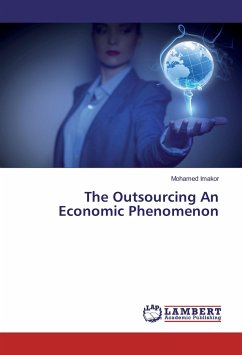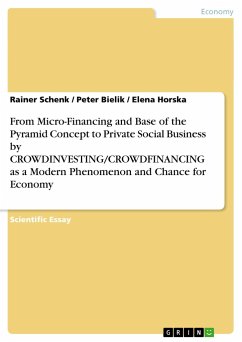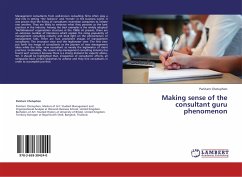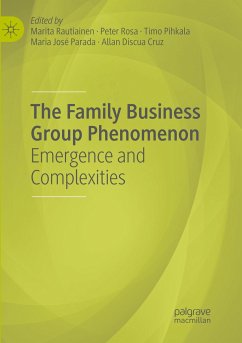
The Burnout Phenomenon
Keys for proactive burnout prevention
Versandkostenfrei!
Versandfertig in 1-2 Wochen
38,00 €
inkl. MwSt.

PAYBACK Punkte
0 °P sammeln!
Scientific Study from the year 2006 in the subject Business economics - Personnel and Organisation, grade: 2,0, Maastricht University (Faculty of Economics and Business Administration, Studiengang International Business), language: English, abstract: Inhaltsangabe:Abstract:Burnout is a multidimensional psychological syndrome that evolves as a reaction to chronic stress in the workplace. It results in an irrevocable depletion of a person s energies and emotional resources with various negative consequences for individuals and organizations. In the past 30 years researchers tried to understand t...
Scientific Study from the year 2006 in the subject Business economics - Personnel and Organisation, grade: 2,0, Maastricht University (Faculty of Economics and Business Administration, Studiengang International Business), language: English, abstract: Inhaltsangabe:Abstract:
Burnout is a multidimensional psychological syndrome that evolves as a reaction to chronic stress in the workplace. It results in an irrevocable depletion of a person s energies and emotional resources with various negative consequences for individuals and organizations.
In the past 30 years researchers tried to understand the burnout construct in its complexity and offered diverse answers to questions of why burnout appears and how it can be measured. But despite the broad academic research on burnout, the knowledge base is still lacking a comprehensive approach on how to prevent burnout from happening and how to alleviate organizations from its the negative implications.
This thesis gives insights by integrating various research findings with tangible management techniques. A theoretical model is constructed for offsetting burnout and its consequences. A list of 12 multidirectional propositions is given that managers may apply to proactively decrease burnout and its effects.
The implementation of effective individual, managerial or organizational patterns to deal proactively with burnout depends largely on manager s clear and accurate understanding of the burnout construct, before acting on its consequences. For that reason it is inevitable for managers to comprehend the burnout phenomenon in its multidimensional and holistic whole.
Accordingly, chapter two will explicate the theoretical burnout construct to a managerial audience. A summary of the historical and empirical research activities will be given in section 2.1 in order to provide a better understanding of how the knowledge base on burnout evolved over time to its current state. Section 2.2 offers explanations for the three burnout dimensions, its construct validity, and the measurement of burnout based on Maslach s model, who, until today, happens to be the most influential scholar in this field.
Chapter three will clarify the antecedents of burnout, identifying various individual and situational factors that have been significantly related to the different dimensions of burnout. The understanding of the psychological conceptualizations of burnout is of central importance, but it does not provide managers with clear and concrete tools to counter the appearance of the burnout phenomenon in their organizations. This has largely been neglected by most burnout researchers. Therefore, in chapter four of this thesis a theoretical model is constructed that can assist managers in their attempt to proactively decrease burnout appearance and its effects. Fundamental to this model is the psychological conclusion of Maslach et al. (2001) who defines six work areas (workload, fairness, community, control, rewards, values) that place the person within the work context and aim at providing a better lever for burnout prevention.
These findings of Maslach et al, Schaufeli, Maslach, and Marek and other various authors who added to today s knowledge base will be integrated with the current state of management theories to build up the model. Following the conceptualization of the model, twelve propositions will be presented that assist managers in their formulation of a burnout prevention strategy.
A concluding part answering the central problem statement and limitations of the pro-posed model with suggestions for further research are presented in the fifth and last chapter of this thesis.
Inhaltsverzeichnis:Table of Contents:
Table of Contents
Chapter I.Introduction4
Chapter II.A literature review on burnout research8
2.1History of burnout research8
2.1.1Pioneering phase8
2.1.2Empirica...
Burnout is a multidimensional psychological syndrome that evolves as a reaction to chronic stress in the workplace. It results in an irrevocable depletion of a person s energies and emotional resources with various negative consequences for individuals and organizations.
In the past 30 years researchers tried to understand the burnout construct in its complexity and offered diverse answers to questions of why burnout appears and how it can be measured. But despite the broad academic research on burnout, the knowledge base is still lacking a comprehensive approach on how to prevent burnout from happening and how to alleviate organizations from its the negative implications.
This thesis gives insights by integrating various research findings with tangible management techniques. A theoretical model is constructed for offsetting burnout and its consequences. A list of 12 multidirectional propositions is given that managers may apply to proactively decrease burnout and its effects.
The implementation of effective individual, managerial or organizational patterns to deal proactively with burnout depends largely on manager s clear and accurate understanding of the burnout construct, before acting on its consequences. For that reason it is inevitable for managers to comprehend the burnout phenomenon in its multidimensional and holistic whole.
Accordingly, chapter two will explicate the theoretical burnout construct to a managerial audience. A summary of the historical and empirical research activities will be given in section 2.1 in order to provide a better understanding of how the knowledge base on burnout evolved over time to its current state. Section 2.2 offers explanations for the three burnout dimensions, its construct validity, and the measurement of burnout based on Maslach s model, who, until today, happens to be the most influential scholar in this field.
Chapter three will clarify the antecedents of burnout, identifying various individual and situational factors that have been significantly related to the different dimensions of burnout. The understanding of the psychological conceptualizations of burnout is of central importance, but it does not provide managers with clear and concrete tools to counter the appearance of the burnout phenomenon in their organizations. This has largely been neglected by most burnout researchers. Therefore, in chapter four of this thesis a theoretical model is constructed that can assist managers in their attempt to proactively decrease burnout appearance and its effects. Fundamental to this model is the psychological conclusion of Maslach et al. (2001) who defines six work areas (workload, fairness, community, control, rewards, values) that place the person within the work context and aim at providing a better lever for burnout prevention.
These findings of Maslach et al, Schaufeli, Maslach, and Marek and other various authors who added to today s knowledge base will be integrated with the current state of management theories to build up the model. Following the conceptualization of the model, twelve propositions will be presented that assist managers in their formulation of a burnout prevention strategy.
A concluding part answering the central problem statement and limitations of the pro-posed model with suggestions for further research are presented in the fifth and last chapter of this thesis.
Inhaltsverzeichnis:Table of Contents:
Table of Contents
Chapter I.Introduction4
Chapter II.A literature review on burnout research8
2.1History of burnout research8
2.1.1Pioneering phase8
2.1.2Empirica...














